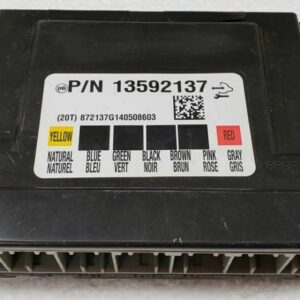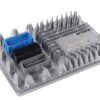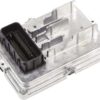Restore Your Vehicle’s Brain without the Dealership Headache
Are you chasing electrical gremlins in your GM vehicle? Flickering lights, malfunctioning power windows, a security system that has a mind of its own, or worse, a car that won’t start? Before you spend a fortune at the dealership, the problem is very likely a failing Body Control Module (BCM). As the central command for your vehicle’s body electronics, when the BCM goes down, it creates a cascade of frustrating and seemingly unrelated issues. This is where our simple, effective solution comes in.
We offer a reliable replacement Programmed GM BCM that is expertly cloned from your vehicle’s original module. This isn’t just a part in a box; it’s a comprehensive service designed to get you back on the road with minimal downtime and zero need for expensive dealer-only programming tools. By transferring the unique data from your original BCM to this replacement unit, we ensure it’s a true plug-and-play fix. All the specific settings for your vehicle’s options, VIN, and security information are perfectly matched.
A Technician’s Notebook: The 2015 Silverado Ghost
A customer brought in a 2015 Silverado 1500 with a laundry list of bizarre complaints. The dome light would stay on, the radio would randomly shut off, and sometimes the turn signals wouldn’t work. They had already replaced the battery and checked fuses. Diagnostics showed a flurry of communication errors (U-codes), all pointing back to one culprit: the BCM. Instead of a new module and a costly programming session, we used a cloning service just like this one. The customer mailed in their faulty BCM, we received the pre-programmed replacement a few days later, and installation took less than 30 minutes. The truck was fixed for a fraction of the dealer quote. This service is the most efficient repair for these common GM electrical failures.
Is Your Vehicle Showing These Signs of BCM Failure?
A failing BCM can manifest in numerous ways. If you’re experiencing any of the following, this module is your likely solution:
- ✔ Intermittent or non-functional power windows, locks, and mirrors.
- ✔ Erratic interior or exterior lighting (headlights, dome lights, dash lights).
- ✔ Instrument cluster gauges behaving abnormally or not working at all.
- ✔ Vehicle security system faults or alarm sounding randomly.
- ✔ A no-start or no-crank condition, even with a good battery.
- ✔ Diagnostic trouble codes related to communication, such as U0140 (Lost Communication With Body Control Module).
- ✔ Malfunctions with the climate control system.
Your Straightforward BCM Swap Guide
Installing your pre-programmed BCM is a manageable job for a DIYer or a quick task for any professional mechanic. While the exact location varies by model (see fitment list), the general process is consistent.
- Safety First: Always disconnect the negative terminal from your vehicle’s battery to prevent electrical shorts.
- Locate the BCM: Find the module. Common locations include under the steering column, behind the left-hand side of the dashboard, or on the firewall.
- Disconnect and Remove: Carefully unplug the electrical connectors. They have locking tabs that need to be depressed. Once disconnected, unbolt or unclip the old BCM and remove it from the vehicle.
- Install the New BCM: Mount your new, pre-programmed module in the same location and securely reconnect all electrical connectors.
- Reconnect and Test: Reconnect the negative battery terminal. Turn the key to the ‘ON’ position and test all body functions—lights, windows, locks, etc.—to confirm the repair.
- Post-Install Checks: In some cases, additional steps may be needed. If the airbag light is on, a professional scan tool is required to perform the ‘Setup SDM Primary Key’ procedure. A ‘Brake Pedal Position Relearn’ may also be necessary for proper brake light and traction control operation.
Disclaimer: Always consult a factory service manual for your specific vehicle for detailed instructions and torque specs.
Verified Fitment for These GM Models
This Programmed GM BCM is a direct-fit replacement for units with part numbers 13592137, 13506935, 13506936, 13587704, or 13594764. Please verify your part number and match your vehicle from the list below:
- Cadillac ATS (2015-2016)
- Cadillac CTS (2015-2016)
- Cadillac Escalade / ESV (2015)
- Cadillac XTS (2015)
- Chevrolet Corvette (2015)
- Chevrolet Impala (2015-2016) (New Style)
- Chevrolet Silverado 1500 / 2500 / 3500 (2015)
- Chevrolet Sonic (2015-2018)
- Chevrolet Suburban 1500 (2015)
- Chevrolet Tahoe (2015)
- GMC Sierra 1500 / 2500 / 3500 (2015)
- GMC Sierra Denali 1500 / 2500 / 3500 (2015)
- GMC Yukon / Yukon XL 1500 (2015)
Frequently Asked Questions
How does the cloning service work?
It’s simple! After you purchase, we will contact you with instructions to ship your original BCM to us. Once we receive it, we extract the critical vehicle data and transfer it to the replacement module. We then ship the ready-to-install BCM back to you.
Do I need to do any programming or flashing myself?
No. The service includes all necessary programming. The module you receive will be completely plug-and-play, with no need for a trip to the dealer or a special scan tool for initial setup.
What if my original BCM is completely dead or not communicating?
In many cases, even if the BCM is failing, the core data on the memory chip is still readable. We are successful in over 98% of cases. If we cannot read your module, we will contact you to discuss options and provide a full refund.
Is there a core charge for this part?
No, there is no core charge. We only need your original module to perform the data cloning service. You are not required to send it back to us after installation, though we recommend it for recycling.
What does ‘w/model year break point (opt AVF)’ mean?
This is a GM production code (RPO code) that indicates a mid-year production change. Our cloning process makes this irrelevant, as we copy your exact vehicle data, ensuring compatibility regardless of production breaks.



